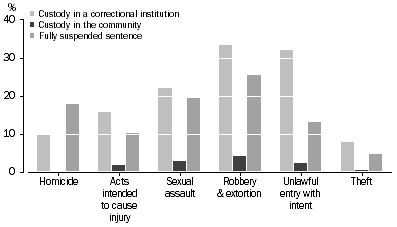SENTENCE OUTCOMES
The following information relates to sentence outcomes for defendants heard in the Magistrates' Courts. Sentence refers to the principal sentence a defendant received which is usually, though not necessarily, the sentence associated with the principal offence. See Explanatory Notes paragraphs 45-47 for further information.
Differences in sentencing are a result of the offence the defendant was convicted of, as well as a range of aggravating and mitigating factors taken into account by the court, such as prior convictions, level of violence, whether the offender was provoked, and demonstrations of remorse. The range of sentences available also differs across states and territories.
Custodial orders
The most serious penalties issued for charges proven in the Magistrates' Courts are custodial sentences. In 2009-10, 9% (46,445) of convicted defendants had custodial orders imposed: 4% sentenced to custody in a correctional institution; 4% sentenced to fully suspended sentences; and 1% sentenced to custody in the community (Table 3.7).
The proportions of custodial orders varied across the states and territories with the largest proportion in the Northern Territory (31%) and the smallest in Western Australia (5%) (Table 3.3).
Defendants convicted of acts intended to cause injury accounted for 26% of all defendants given custodial sentences, followed by defendants convicted of traffic offences (23%). Defendants convicted of theft accounted for 9% of custodial sentences.
The types of custodial orders issued varied across principal offences. Custody in a correctional institution was the most common principal sentence for those convicted of robbery and extortion offences (33%), followed by unlawful entry with intent (32%). Robbery and extortion and sexual assault offences were the principal offences for which fully suspended sentences were most commonly ordered (26% and 20% respectively) (Table 3.7).
DEFENDANTS PROVEN GUILTY, Selected principal offence by type of custodial order

The proportion of male defendants who received a custodial sentence was almost double that of women (10% and 6% respectively). Of the 39,870 males who were sentenced to a custodial order, over half (51%) were sentenced to custody in a correctional institution. In contrast, the majority of females issued with custodial orders were given fully suspended sentences (53%) (Table 3.8).
Non-custodial orders
The majority of convicted defendants (91% or 478,210) were given non-custodial sentences, such as community supervision or work orders, monetary orders, or good behaviour bonds. The proportion has not changed since 2003-04.
The most common non-custodial sentence was a monetary order, with nearly three-quarters (71% or 370,532) of defendants proven guilty receiving this sentence.
Monetary orders were the most common sentence issued to defendants convicted of traffic offences and dangerous or negligent acts endangering persons (84% and 77% respectively) (Table 3.7).
Community supervision or work orders were the most common non-custodial sentence for those convicted of unlawful entry with intent (23%), and robbery and extortion offences (16%).
DEFENDANTS PROVEN GUILTY, Selected principal offence by type of non-custodial order

There were some differences across age groups in the types of non-custodial orders issued. Convicted defendants aged under 25 years had a higher proportion of defendants issued with community supervision/work orders (6% of defendants in this age group) than those aged 45 years and over (3%) (Table 3.8).
DEFENDANTS PROVEN GUILTY, Age groups by selected non-custodial sentences

 Print Page
Print Page
 Print All
Print All